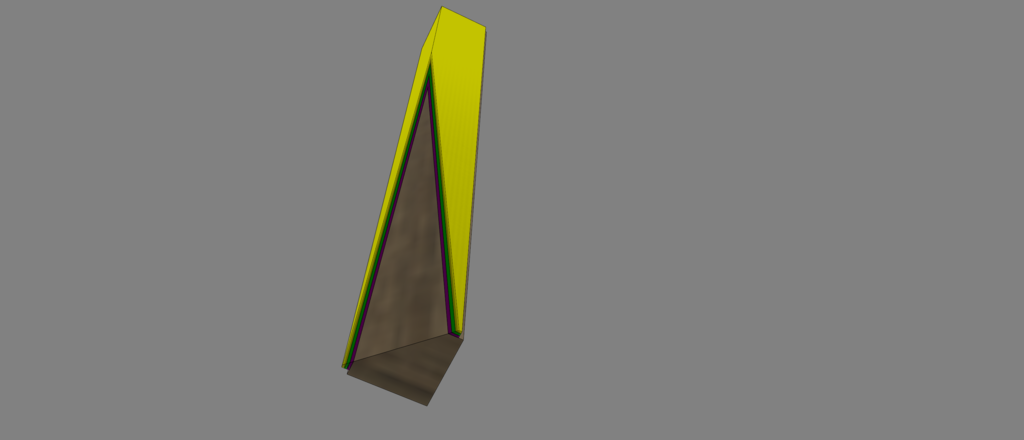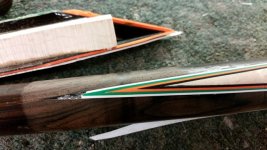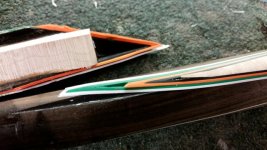Guitarmakers use a solvent based glue to install plastic bindings, I believe it actually "welds" the glue to the wood. Aside from that you could try using an endmill and cutting from the top down using the tip of the tool...
You are using an out of date browser. It may not display this or other websites correctly.
You should upgrade or use an alternative browser.
You should upgrade or use an alternative browser.
ISO WICO points
- Thread starter ratcues
- Start date
Just a thought from the "cheap seats" but...
Have you tried plastics specific adhesives? Like you get for joining plumbing pipes? I believe that stuff "welds" the plastic. Maybe something like that?
.
Yes, I have. Even when I find an adhesive that works with the plastic veneer, I still need to be able to glue it into the rosewood forearm and the maple point.
Yes, I have. Even when I find an adhesive that works with the plastic veneer, I still need to be able to glue it into the rosewood forearm and the maple point.
Oh yeah, I think you mentioned that before.
Wow, this really is a conundrum. It does make one respect the original development. And of course all those cues that were produced.
I have an old Gandy with WICO points, this makes me respect it more. I have a couple of Vikings with vinyl points too, one with a stack of 9 vinyl veneers.
Makes me think there is some secret to it. A mystery of cuemaking that only a few know and they aren't talking?
.
Ryan,
I didn't see this suggestion in the thread but might have missed it. Have you tried reaching out to someone who has a 3D printer to make them? I think most printers can get down to .060. I have a friend who prints all of my pantograph templates for me.
Erich
I didn't see this suggestion in the thread but might have missed it. Have you tried reaching out to someone who has a 3D printer to make them? I think most printers can get down to .060. I have a friend who prints all of my pantograph templates for me.
Erich
Could you coat the outside of your veneer stack with ca or something that binds to the plastic then use epoxy that will bind to the ca? Something that will act as a glue primer.
Again I'd try luthier supplier like StewMac. Luthiers have been gluing plastic bindings on guitars for almost a century.
Another idea is to tape the points and veneers to the forearm, then use water-thin CA and place drops right where the plastic and wood meet. The CA will wick into the joint. I do a bit of binding this way. I would put a coat of sealer on the area as to not stain the wood with the CA...
Another idea is to tape the points and veneers to the forearm, then use water-thin CA and place drops right where the plastic and wood meet. The CA will wick into the joint. I do a bit of binding this way. I would put a coat of sealer on the area as to not stain the wood with the CA...
For this you must think outside the box
I think John Bender would be a good person to consult as the answer lies within (literally within) some of his fancy point work. If you study those points you will find some material had to be removed and replaced with other materials.
I think John Bender would be a good person to consult as the answer lies within (literally within) some of his fancy point work. If you study those points you will find some material had to be removed and replaced with other materials.
this is obviously easier said than done but i would try this. Mill off the back of the point stock assembly and glue a new piece of wood to the back. Then re-mill everything true again. This will effectively capture the veneer within the 2 pieces of wood and afford you an actual piece of base wood to glue into the forearm. Just a thought


Wow.
I have been thinking aerospace...all kinds of stuff. I mean, they got the tiles to stick to the shuttle.
Then I was thinking if I had to stick something together right now...and it had to hold...I would go to Home Depot and get some construction adhesive.
Crazy? I dunno....just commenting from the cheap seats.
.
I have been thinking aerospace...all kinds of stuff. I mean, they got the tiles to stick to the shuttle.
Then I was thinking if I had to stick something together right now...and it had to hold...I would go to Home Depot and get some construction adhesive.
Crazy? I dunno....just commenting from the cheap seats.
.
They didn't look too bad until they started to chip and peel...
View attachment 458394
View attachment 458395
damn...i feel for you. From the looks of how that particular plastic is working it may only be viable to use them in a flat bottom pocket. (cnc'd)
Wow.
I have been thinking aerospace...all kinds of stuff. I mean, they got the tiles to stick to the shuttle.
Then I was thinking if I had to stick something together right now...and it had to hold...I would go to Home Depot and get some construction adhesive.
Crazy? I dunno....just commenting from the cheap seats.
.
thats a good thing....sometimes the specialist's imagination is limited to his pre-disoposition. Different perspectives and thinking is probably what this project requires.
thats a good thing....sometimes the specialist's imagination is limited to his pre-disoposition. Different perspectives and thinking is probably what this project requires.
Thanks.
I am aware that bonding dissimilar materials is a specialty area of adhesives development. Even if the adhesive previously used is obsolete I am confident there is a replacement. Wood is becoming less common as far as materials, but it isn't completely obsolete. And it is porous anyway, which makes it the easier material in the equation as far as I know.
There is an adhesive out there I think, it is just a matter of finding it.
.
Thanks.
I am aware that bonding dissimilar materials is a specialty area of adhesives development. Even if the adhesive previously used is obsolete I am confident there is a replacement. Wood is becoming less common as far as materials, but it isn't completely obsolete. And it is porous anyway, which makes it the easier material in the equation as far as I know.
There is an adhesive out there I think, it is just a matter of finding it.
.
And what ever it is, has to be clear, IMO, otherwise it will show. My thoughts, for what they are worth, is wipe the rosewood pocket with acetone, then dry, then seal it with a couple thin coats of CA so the oils in the wood are locked out, and the epoxy will bond to it later. Then lightly sand the plastic veneers and clean with acetone, that will make a better bonding surface. Then thin coat them with CA. Lightly sand or abrade, the point pocket and the point blanks but don't go thru the CA layer, then clean with acetone, then I would think a good thin epoxy like west system 206 would do the trick. Just one method. I think I would try it on a mockup first, not the original forearm. I wish Ryan Good Luck and hope all comes out well.
Dave
The original glue failed as well so even if I knew what it was, I wouldn't use it.
The first attempt to glue the veneers together, I use a 24 hour epoxy, which I have absolute faith in. I scuffed all the surfaces. It failed.
My second attempt, I used a PVC-specific glue. It held better than the epoxy, but still failed.
I have a couple of new ideas PMed to me that I need to try on my next attempt but I am confident I'll get it figured out.
The first attempt to glue the veneers together, I use a 24 hour epoxy, which I have absolute faith in. I scuffed all the surfaces. It failed.
My second attempt, I used a PVC-specific glue. It held better than the epoxy, but still failed.
I have a couple of new ideas PMed to me that I need to try on my next attempt but I am confident I'll get it figured out.
I hesitate to give an answer to this, but I will anyway.Just a thought from the "cheap seats" but...
Have you tried plastics specific adhesives? Like you get for joining plumbing pipes? I believe that stuff "welds" the plastic. Maybe something like that?
.
There really is no such one thing as a "plastic specific adhesive." And just in this thread, we have posters saying that the WICO points are PVC, and the one person that I trust the most to actually have done research says it might be ABS. The two plastics are very different, so one "plastic-specific adhesive" might create cracks in one of these plastics, and it might release unwanted gasses in the other.
Laminating sheets of PVC and laminating sheets of ABS use different adhesives and techniques, and it all depends on the desired outcome.
Freddie <~~~ and away we go
I hesitate to give an answer to this, but I will anyway.
There really is no such one thing as a "plastic specific adhesive." And just in this thread, we have posters saying that the WICO points are PVC, and the one person that I trust the most to actually have done research says it might be ABS. The two plastics are very different, so one "plastic-specific adhesive" might create cracks in one of these plastics, and it might release unwanted gasses in the other.
Laminating sheets of PVC and laminating sheets of ABS use different adhesives and techniques, and it all depends on the desired outcome.
Freddie <~~~ and away we go
Yes, I get that.
I should have said an adhesive specific to that plastic. :wink:
.

